MITKUNSTZENTRALE and SATELLIT (2024)
two places we work together and
initiated together to deal with...
...Collaborative work:
mitkunstzentrale.de
...Community work:
satellit.info
BRITZENALE (2021)
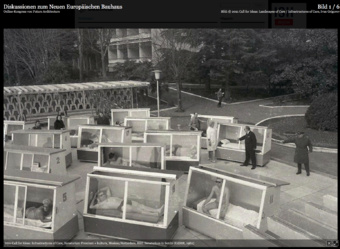









6.-8.August 2021
Die Berlin Britzenale ist ein interdisziplinäres Ausstellungsprojekt inmitten einer Kleingartenanlage im Neuköllner Stadtteil Britz. Auf der Anlage mit 62 Parzellen, die zwischen 200 und 400 qm groß sind, untersucht die ‘Biennale von Britz’ dieses räumlich und sozial für Berlin kennzeichnende Modell und öffnet es für ein Wochenende der Öffentlichkeit.
Kleingärten bilden in Berlin eine historisch gewachsene, kulturell, ökologisch und sozial bedeutende Ressource. Das gestiegene Umweltbewusstsein, nachhaltiges Konsum- und Ernährungsverhalten sowie die andauernde Pandemie haben die ‘Schrebergärten’ und das Urban Gardening höchst attraktiv gemacht.
Das Ausstellungsprojekt Berlin Britzenale mit seinen wechselnden Themenschwerpunkten möchte eine bewusste Öffnung der Kleingärten für die Allgemeinheit erreichen und den Dialog und Diskurs zwischen Kunst und Kleingarten ermöglichen.
Über das Flanieren durch die Anlage eröffnet sich der Ort mit seinen kleinen Einheiten in seiner Gesamtheit und lässt Herangehensweisen, Zeitschichten und verschiedene Gestaltungsansätze bewusst betrachten, was in der Regel - wenn überhaupt - nur flüchtig geschieht. Für die künstlerische Umsetzung gehen die Künstler*innen für die dritte Ausgabe der Berlin Britzenale nun einen Dialog mit den Pächter*innen und ihren jeweiligen Gärten ein.
Die beteiligten Künstler*innen 2021 waren:
Art Ashram (Kollektiv), Marina Camargo, Bogomir Ecker, Erik Göngrich, Vanessa Henn, Deborah Jeromin, Kathrin Köster & Yala Juchmann, André Linpinsel, Pätzug / Hertweck, stay hungry (Michel Aniol, Anaïs Edely, János Fodor & Meike Kuhnert), Matthias Schamp, Sonya Schönberger, Pola Sieverding, Stefania Smolkina, 44flavours (Sebastian Bagge und Julio Rölle) und Alvaro Urbano.
ORIGINAL (2020)
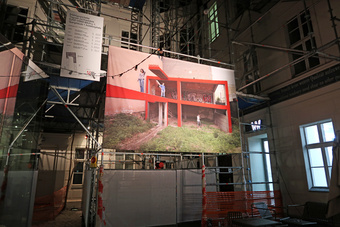

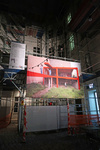






First it was just a found situation with a concrete structure that occupied a piece of land in the center of ROME.
Then the owner cleaned the field from the green and the sculptural character of that structure appeared.
This was reason enough to build a 1:5 Model of the Structure and name it ORIGINAL.
You could read it as a inverse Ready made.
On the invitation poster for the show at leporello the "modern studiolo" was manifested.
It was all these steps before we got the allowance to really paint the house red and the letters up.
The photo of that ready made sculpture was part of a show in the romantic garden of villa massmo in Rome.
Back in Berlin the Photo was exhibited on the building site scaffolding in the courtyard of KW.
There it was put back in the context of city-transformation and it almost got a proof of evidence for the manifesto of "The unfinished" of alterazione video where they manifested that all these unfinished concrete ruins in italy are THE (one and only) real style that architecture in italy produced in the last 100 years. The contemporary ruin like the old roman ruin.
All you touch and all you see / is all your life will ever be / RUN RABBIT RUN / Dig that hole, forget the sun. (2020)
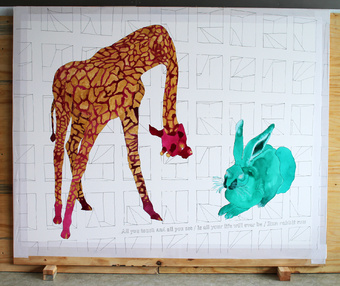




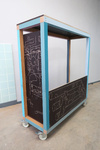
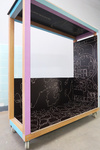


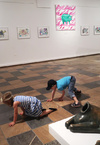

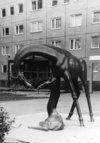
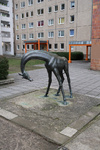

Urbane Kommentare
mit
Sibylle Bergemann, Herbert Bergmann-Hannak, Christian Borchert, Jan Brokof, Herdegen Fehlhaber, Günther Friedrich, Erik Göngrich, Joachim Jansong, Thomas Kläber, Konrad Knebel, Max Lingner, Otto Möhwald, Gerhard Kurt Müller, Franziska Neubert, Uwe Pfeifer, Stefan Plenkers, Ulf Raecke, Evelyn Richter, Ute Richter, Erik Seidel, Oskar Erich Stephan, Susanne Theumer, Michael Voll, Walter Womacka, Ulrich Wüst, Rainer Zille sowie Kooperationsmodule der Sommerschule Viadrinicum / Europa-Universität Viadrina
Dauer: Samstag 13.6. bis Sonntag 30.8.2020
Geöffnet: dienstags bis sonntags von 11 bis 17 Uhr.
Die Ausstellung wird ohne Vernissage eröffnet.
Brandenburgisches Landesmuseum für moderne Kunst
Rathaushalle Marktplatz 1, 15230 Frankfurt (Oder)
Kasse +49 335 283 961 83
DOUBLE ELEGANCE (2019)
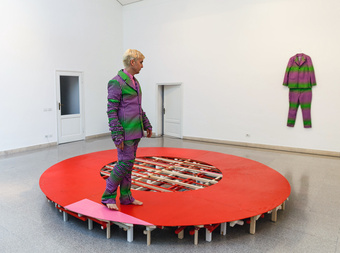









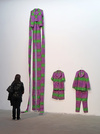
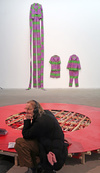
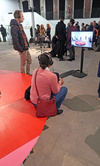
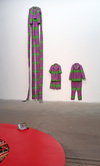
Material:
Real Wax Fabric made by sunbelt from Ghana 2018
Stolen by vlisco / Holland from Java in 1850
Imported to Africa by vlisco around 1880
Produced by Ghana Textiles Printing Company Limited since 1960
Today also printed by hittarget in China
Renamed as Fancy Prints From China.
Bought 2019 at New Esquilino Market in Rome
Suit:
Rita Quinto, Rome, 2019
Stage:
Erik Göngrich, 2019
Music:
Luis da Silva, Embrace, 2019
Performance / 5min. / 13.6.1919 / vimeo.com/344292404
50 Jahre Ruhender Verkehr: PLAKAT (2019)
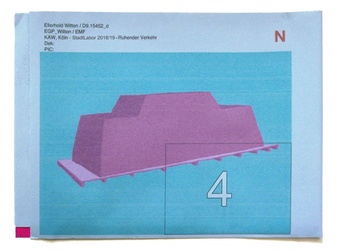









Präsentation einer dreiteiligen Plakatserie von Erik Göngrich im im April - Mai- Juni 2019 an 15 Standorten im Kölner Stadtraum.
Eine Aktion von Uschi Huber und Boris Sieverts mit Erik Göngrich im Rahmen von StadtLabor.
Fotos der Plakataktion: StadtLabor 2018/19
Underchallenged Public Space - Unterforderter Aussenraum (2019)
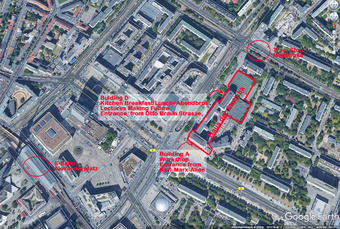



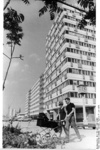








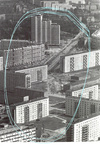
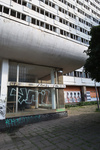
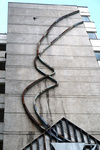
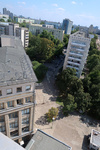
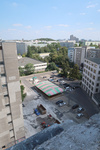
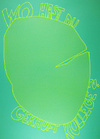
Workshop with students from Bergen Architecture School
Held by Erik Göngrich from 2.-13.Sept. 2019 im Haus der Statistik, Berlin
The workshop will turn around:
Art in Cityspaces – Cityspaces in Architecture – Architecture in Art
Cityspace as Art – Art as Architecture – Architecture as cityspace
We are looking at:
The old Landsberger Alleethat nearly vanishes in the modern city grid. We will follow the traces of that street from Haus der Statistik to Platz der Vereinten Nationen. We will find out:
How is the space used? And where? Are there corners you like to react on? How is it possible to condense this under-challenged modern public space? Do you think a modern city is creating modern art? Where would you like to react artistically and where architecturally? Would you like to develop a house or a sculpture for a specific place? More generally speaking: What could be an intervention for you?
We will work with drawings:
Every day a drawing
Drawings as sculptures in the public realm
Drawings to sharpen a conception
Drawings and texts as installations in space that are tangible Situations for specific places
Drawing as communication tool without talking
Drawing as a document
Drawing as a signifier
Drawings as body extensions, intellectually and physically
Graphic Recording as representation of spaces and attitudes
Drawings for Demonstrations and as performativity Design
…
In general I would like to work with / focus on drawings that will be accompanied by photos, texts, models, installations, music, performance, cooking, sculpture, walks…..
Our common display will be:
For the final presentation each person will use a wooden door panel (that are originally used in of Haus der Statistik) to present their drawings and ideas.
Erik Göngrich
Berlin 19.8.19
In Moabit bei der Arbeit und gleichzeitig beim Schlossneubau und in Marzahn/Hellersdorf. (2015)
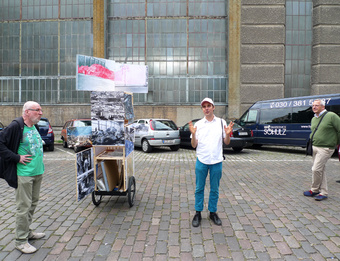




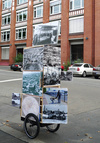
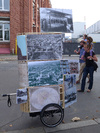








Stadtführung mit Bilderkarren
Einmal um das Siemensgelände im Westen Moabits
Am Sonntag 13.Sept. 2015 um 15:00
Treffpunkt: AEG-Turbinenhalle von Behrens in der Huttenstraße Ecke Berlichingenstraße
Ausgehend von der städtebaulichen Situation am Industriestandort Moabit und seiner Mischung aus Gründerzeit-Wohnblöcken und Großbauten, wie der Turbinenhalle von Peter Behrens, richtet Erik Göngrich seinen Blick auf ganz Berlin. Anhand von Bildern reflektiert er das Thema Arbeit in der Architekturmoderne des 20. Jahrhunderts in Ost- und West-Berlin und widmet sich urbanen Veränderungsprozessen bis hin zu der neuralgischen Frage: Welche Schlösser braucht man für internationale Kulturen?
Zu ICH, um WIR zu sein? (2014)
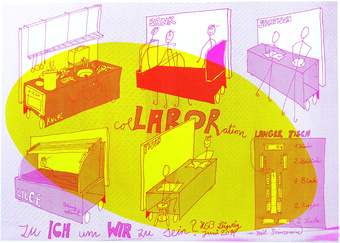

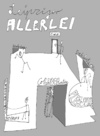
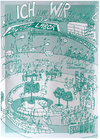





















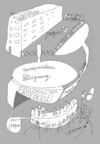

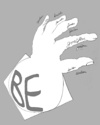
Experiments in collectivity
Hochschule für Grafik und Buchkunst / Leipzig
With: Stephanie Nava (F), Olivia Plender (GB), Meggie Schneider (D), Alexander Römer (constructLab und EXYZT F/D), Erik Göngrich (D), Thomas Rustemeyer (D)
When: 1st to 15th June 2014
Where: In and around the gallery space of the Art Academy Leipzig
It is always about the result.
About the perfect space, the freshly painted white walls, the right position of the artwork, the discreetly hidden cable.
All the effort is focused on the moment of the opening. The act of questioning the works in the space, the try-out, the rejecting, replacing, and changing is of no or very little interest and should ideally leave no traces. The conditions of the artistic process seem to play no role.
Leading questions - What happens:
When the process of producing and questioning becomes relevant?
When not the result but the process is the pivotal point?
When collective creating is put forward instead of presentation?
When artists get the time and the means to indulge into a 2-weeks lab situation to broach the issue of collaborative work?
Musée de ... / Museum of... (2011)
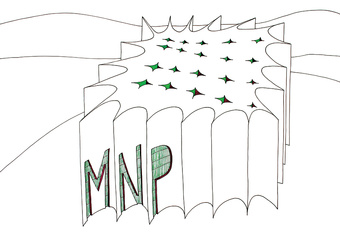














Cajarc/Frankreich und Tiergarten/Berlin
MNP - Musée des Noix et des Pommes
MCF - Musée du Cochon et du Fromage
MBCV - Musée des Bars et du 2CV
MPTPP - Musée des Pommes de Terre et des Petit-Pois
MCAB - Musée des Cavernes et d’André Breton
MPO - Musée des Poissons et des Oeufs
MW+MB - Musée du Week-end et des Boules
MBS - Musée des balcons et des scènes
MDC - Musée des distances et des châteaux
MTES - Musée de la Tour Eiffel et du Sablier
MVE - Musée des Vaches et des Escargots
MPV - Musée de la Piscine et du Vin
MVP - Musée de la Vue et de la Poire
MCC - Musée du Canard et du Chapeau
MFP - Musée de la Fraise et de la Patrimoine
MDB - Museum of Dog Kennels and Birdcages
MBM - Museum of Berlin Mayors
MKC - Museum of Kitchens and Crossroads
MSP - Museum of Sitting Rooms and Parks
MPF - Museum of Pistols and Bottles
14+ Watercoulours, size: 76 x 56 cm, some framed
The Beginning of the Missunderstanding / Architecture or Rain (2011)
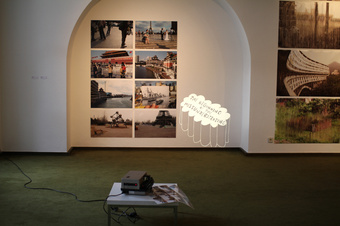



The Beginning of the Missunderstanding : Acht Fotografien (40x60cm) und eine Diaprojektion
Architecture or Rain: 16 vom Regen verwaschene Fotografien (70x100cm)
STUDIOLO, Berlin, Paris, Brest, Cajarc, Rosenheim (2010)
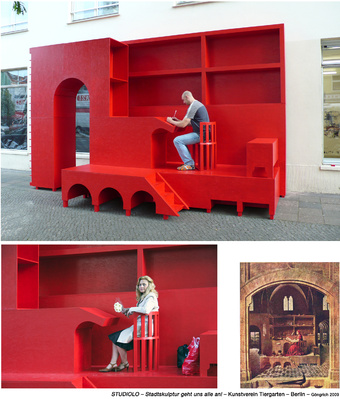
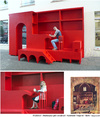

The privilege of having a study space was one that was long only available to men, as was intellectual activity in general. As a result of her position in society, Isabella d’Este in Mantua represented an exception to the rule in the late fifteenth century. Isolated study became acceptable for women from the eighteenth century onwards, as the position of women in society became stronger and their aesthetic, intellectual and erotic powers received more recognition. As a result, intellectual activity was considerably influenced by women, who encouraged it in communal salon rooms. (Cora Hegewald)
One image that has always been important to me is a very small Renaissance painting (45.7 • 36.2 cm)— St Jerome in his Study, german title: Der heilige Hieronymus im Gehäus, around 1475– by Antonello da Mes sina (active around 1456, died in 1479). I often took a postcard of it, which I bought in the National Gallery of London in 1994, with me when I travelled around. I prefer the poetic German version of the title: Heiliger Hieronymus im Gehäuse (literally Holy Jerome in His Cabinet). In this painting, we see St Jerome sitting on a wooden platform with a table, a bench and shelves. All of the elements are organised to create a little room for his studies — a studiolo. This wooden room looks like a freestanding object in a much bigger Gothic space that could be a palace or a church. The whole studiolo as a sculpture appears to be presented like a window display. One looks from a bright sunny outside through an opening without doors into a darker inside (space); it almost feels like looking into a glass cabinet. (Erik Göngrich)
The Studiolo Sculpture was exhibited with: Kunstverein Tiergarten, Berlin 2009; Atelier/TRANS305, Paris 2010; centre d'art paserelle, Brest 2010/11; Centre d'art contemporain Georges Pompidou, Cajarc 2011 and sims-gallery, Rosenheim 2011
BANNKREIS (1994)
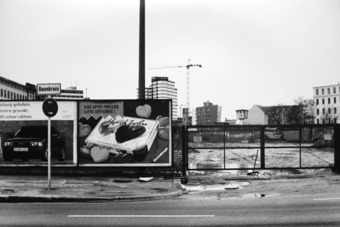




























BANNKREIS - 28 Fotografien der Bannkreis-Schilder um den Berliner Landtag.
Bis zum Baubeginn des Potsdamer Platzes gab es einen durch Schilder markierten Bannkreis um den Berliner Landtag. Entlang der Leipziger Straße, Wilhelmstraße, Anhalter Straße und Stresemannstraße standen um den Landtag ca. dreißig 30 x 50cm große Schilder, die diesen aus der Versammlungsfreiheit herausgenommenen Bereich markierten.